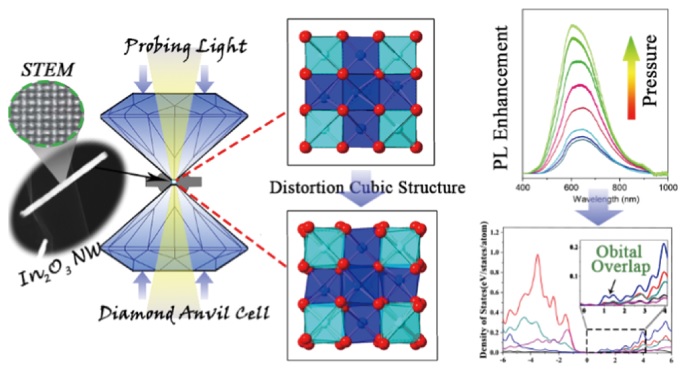“Pressure-Induced Enhancement of Optical Properties in Indium Oxide Nanowires”
- Authors
P. Shen, D.A. Blom, S. Shao, J. Choi, T. Vogt, Y. Ma, L. Wang, Y. Lee*
- Journal
Journal of Physical Chemistry C
Vol.124, pp.10244-10251, 2020.04 - DOI
Abstract
Tuning of physical properties opens up opportunities for new applications of known materials, as the changes induced by hydrostatic pressures can sometimes be mimicked by chemical pressures created by appropriate substitutions or at the interfaces. In contrast to bulk In2O3, where photoluminescence (PL) is reduced by pressure, pressure-induced photoluminescence enhancement (PIPE) by a factor of 4.4 was found in In2O3 nanowires (NWs). Density functional theory (DFT) calculations indicate that PIPE in NWs may be ascribed to the orbital overlap between oxygen-induced defect levels and the conduction band minimum (CBM), which does not occur in bulk In2O3. Both the PL intensity and absorption spectra of In2O3 NWs point to a discontinuity near 16 GPa. Rietveld refinements indicate that these changes in optical properties are concomitant with structural distortions, leading to strained bonds in the InO6 octahedra and trigonal prisms. The optical transmittance (T) of the NWs after compression up to 5.29 GPa is reversible after the pressure release. However, NWs compressed to 12.27 GPa and then reinvestigated at ambient pressure reveal that T increases. At compressions of up to 24.85 GPa, T at ambient conditions was enhanced by 8.29%. Synchrotron X-ray scattering and Raman spectra of NWs compressed to 24.85 GPa indicate that a local distortion of the cubic bixbyite structure is present at ambient conditions. This study establishes a correlation between changes in PL and T of In2O3 NWs and local structural distortions resulting in oxygen-induced defects, which overlap with the conduction band states as suggested by DFT calculations. Our work suggests that the optical properties of ternary metallic oxide NWs with bixbyite structure might be improved by appropriate substitutions.












